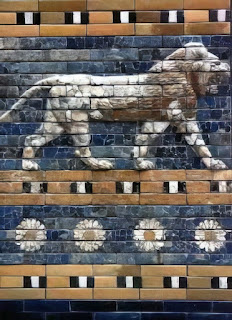In both my Cyropaedia and Achaemenid Mythology army lists, Cyrus the Great is a Hero general. That’s it. There’s no Rider general option for him at all. All other Persian generals are Riders, but not Cyrus the Great. So, how come?

This post is a companion piece to
The Army of the Cyropaedia
Well, Cyrus the Great is no mere people manager on the battlefield. He starts and wins fights, leads aggressively from the front, inspires his troops, is more than a normal man, is the instrument of god on Earth and slays monsters to boot. What more do you want?

Cyrus the Hero General
Oh, you’d like some proof…
Well, Cyrus the Great was the most successful general in the ancient world until Alexander. The Persians celebrated his achievements in song and story. The Magi priests guarded the tomb of Cyrus at Pasargadae, and they sacrificed there a horse monthly down to the last days of the empire.

But fame and success alone do not a Hero make. So, for evidence, let’s delve a bit deeper into the Cyropaedia and elsewhere.
To Xenophon, Cyrus was the very model ethical and idealized ruler and conqueror of unparalleled wisdom, competence, justice, generosity and piety. Herodotus represented Cyrus as the great conqueror, while Ctesias had him as a romantic adventurer who triumphed against the odds.

And since Xenophon, Herodotus, Ctesias derived at least some of their knowledge of Cyrus from Iranian oral tradition, it’s worth a look at the Shahnameh, the great Persian epic poem by Ferdowsi which is the preeminent written source for Iranian mythology.
The Shahnameh’s mythical King Kai Khosrow has been closely linked to Cyrus. So much so, that scholars from the nineteenth to the mid twentieth centuries argued that Kay Khosrow was in fact Cyrus the Great.
Even today, theories that the stories of Kay Khosrow and his Kayanid dynasty may give some historical insight into the early history of the Achaemenids are still being presented.

According to the definition in HOTT, Heroes are “charismatic individuals” who are “made nearly unbeatable in hand to hand combat by exceptional strength, skills... or favouritism of gods.” They are “suited to battling dragons and magicians and to leading lesser troops.”
So, let’s start with the charisma of Cyrus.
The stories of the early life of Cyrus in Herodotus and Xenophon, although differing in their details, follow the same basic structure as for the mythical king Kai Khosrow.
That is, a baby of royal birth is ordered to be killed by a jealous grandfather but saved from death by being hidden away with a lowly family.

King Astyages sends Harpagus to kill the baby Cyrus
However, and this is the important bit, as Cyrus grows older his superior spirit, and his kingly and heroic traits betray themselves in games and exercises. His grandfather eventually recognises Cyrus through his deeds. They reconcile and Cyrus goes on to conquer an empire.
So, charismatic? Check!

How about the exceptional strength and skills bit?
I think Xenophon has the answer:
As a youth:
“Cyrus was ever in the front, like a young hound, untrained as yet but bred from a gallant stock, charging a wild-boar recklessly; forward he swept, without eyes or thought for anything but the quarry to be captured and the blow to be struck.”

Cyrus hunting wild boar*
And in the Shahnameh, a 10 year old Cyrus / Kai Khosrow was a fierce warrior who hunted wild wolves, boars, bears, panthers and lions with a curved stick.
In battle:
“It was he (Cyrus) to whom the engagement was due, and the victory; but the boy's daring was on the verge of madness”
“Then Cyrus, when the moment came, began the battle-hymn and it thundered through the host. And as it died away the war-cry rang out unto the God of Battles, and Cyrus swooped forward at the head of his cavalry, straight for the enemy's flank, and closed with them then and there.... A short struggle, and the ranks broke and fled before him headlong.”
So, exceptional strength and skills: Check

Was he any good at “leading lesser troops?”
Back to Xenophon:
“Cyrus was convinced that no one has a right to rule who is not superior to his subjects.”
In one battle, Cyrus himself dashed forward at the head of his cavalry shouting: "Brave men to the front! Who follows me? Who will lay the first Assyrian low?"
A leader of men? Check!

Did Cyrus have the “Favouritism of gods?”
In the Old Testament Isaiah hails him as Yahweh's anointed, chosen and named by Israel's god to destroy Babylon.

Cyrus liberates the Jews from Babylonian captivity
and rebuilds Jerusalem
Aeschylus in his Persae, has Cyrus winning divine favor through right-mindedness.
The favour of the Gods? Check!

The four-winged guardian figure representing
Cyrus the Great from Pasargadae
Was Cyrus any good at battling dragons and magicians?
I think we’ll have to go mythological with this one! In the Shahnameh, Kay Khosrow’s qualification as crown prince included that he had God-given glory, and he had destroyed a fortress occupied by dēvs (Zoroastrian demons).
In Persian/Arabic tradition, Kay Khosrow killed a dragon which terrorized men and destroyed crops.
Cyrus, killer of monsters? Check!

So, is Cyrus the Great Hero material?
Check! Check! Check!
Sources:
* Photo Attribution:
User Coyau on Wikimedia Commons, Painting of Cyrus the Great in battle, CC BY 3.0
Cyropaedia The Education of Cyrus by Xenophon Translated by Henry Graham Dakyns
The Ancient Iranian Perception of Cyrus the Great by A. Mani Irannejad
The Cyrus Legend in the Sahname - Wladyslav Duleba
Cyrus the Great of Persia: images and realities by Amelie Kuhrt
Hit me up with your comments.
If you like these posts, why not
"Like"
Wargrunt Art on Facebook for updates
Just click here



























